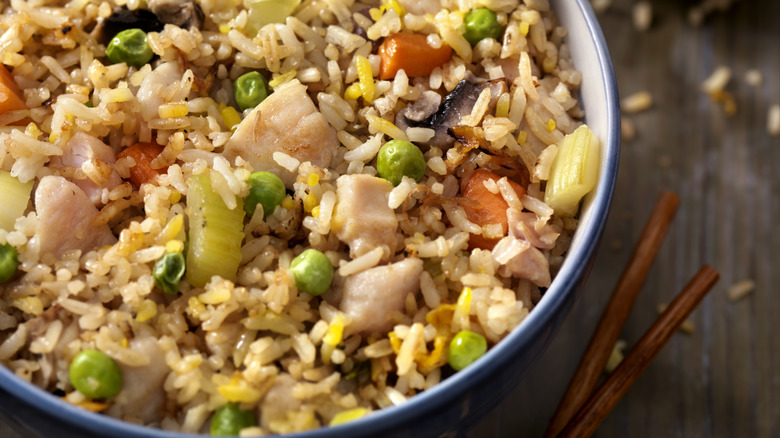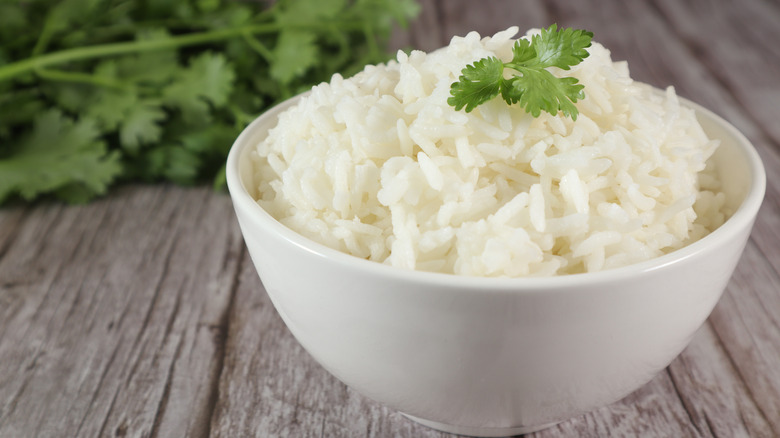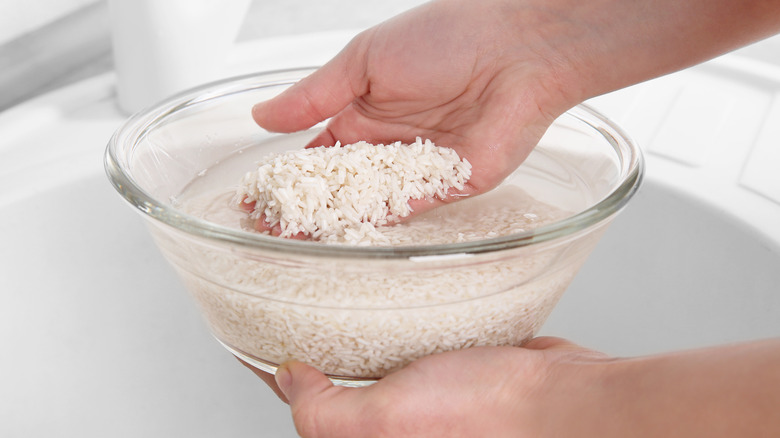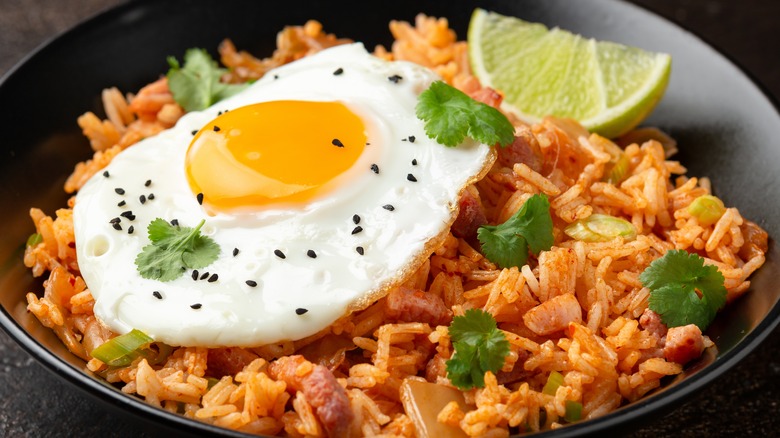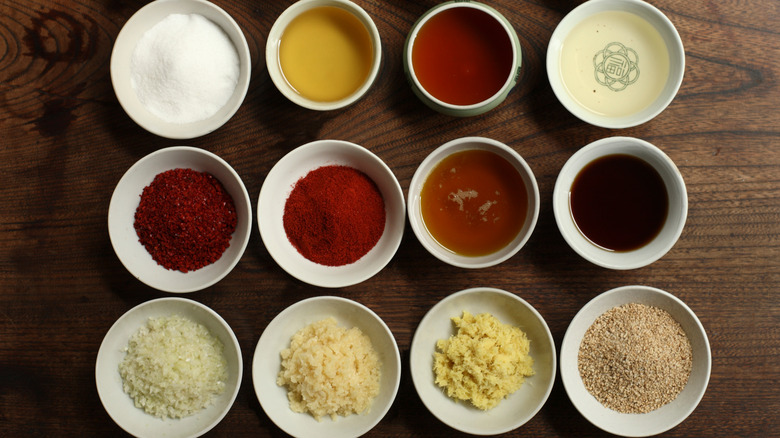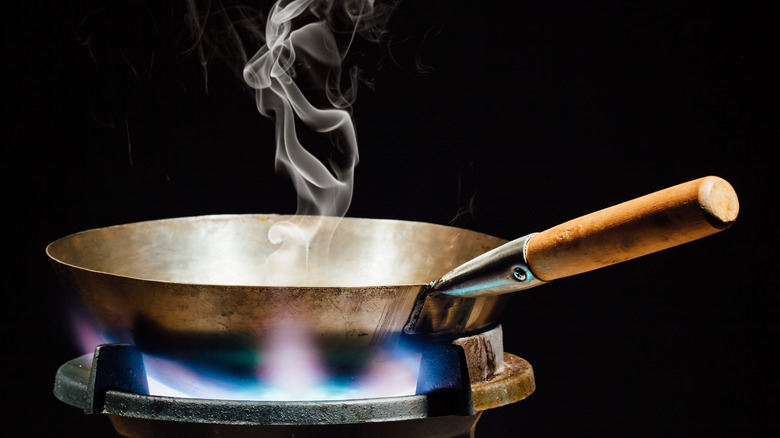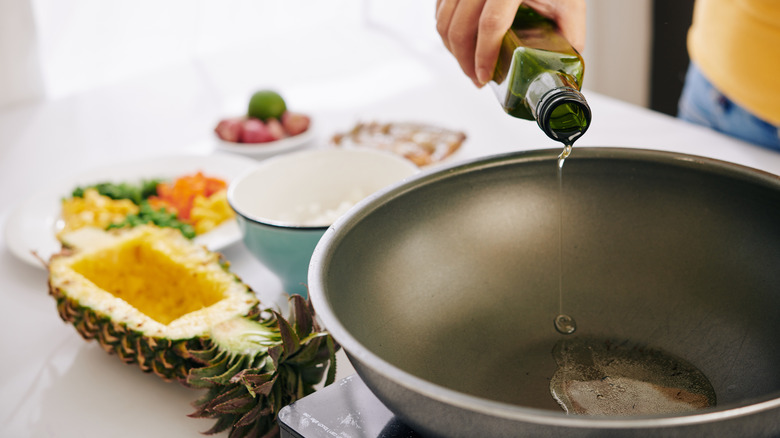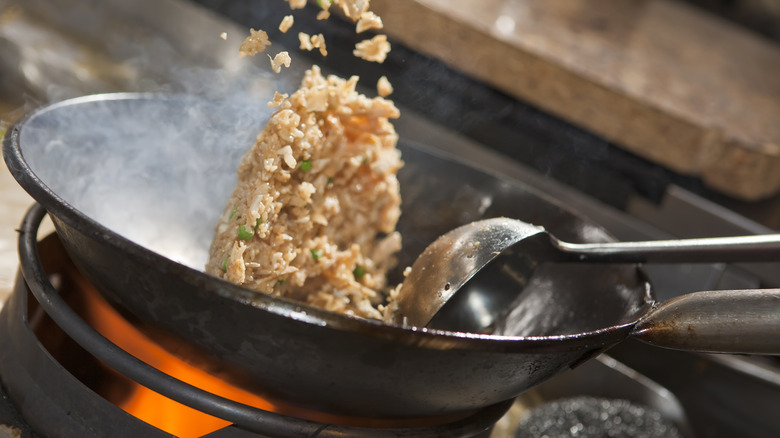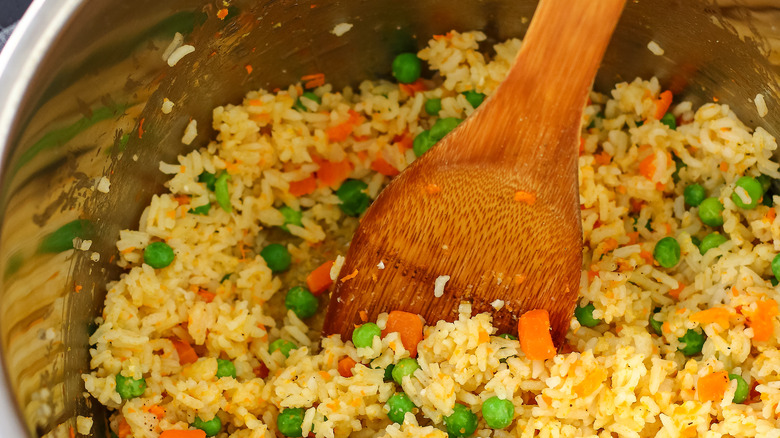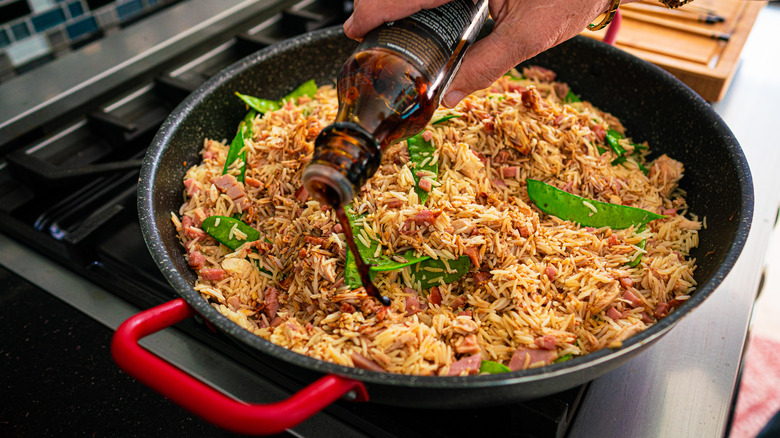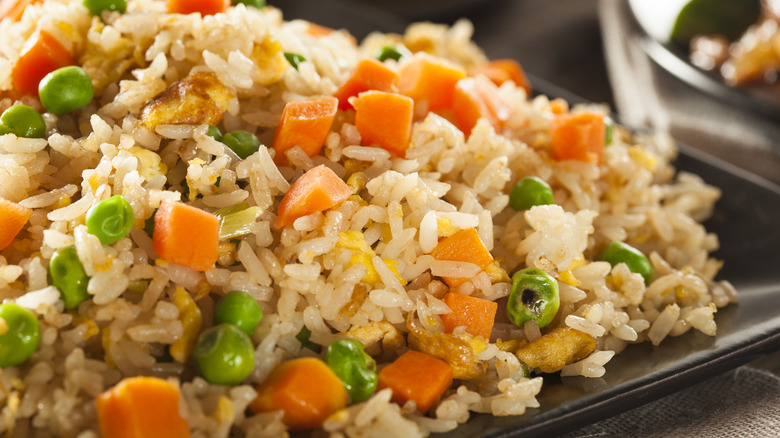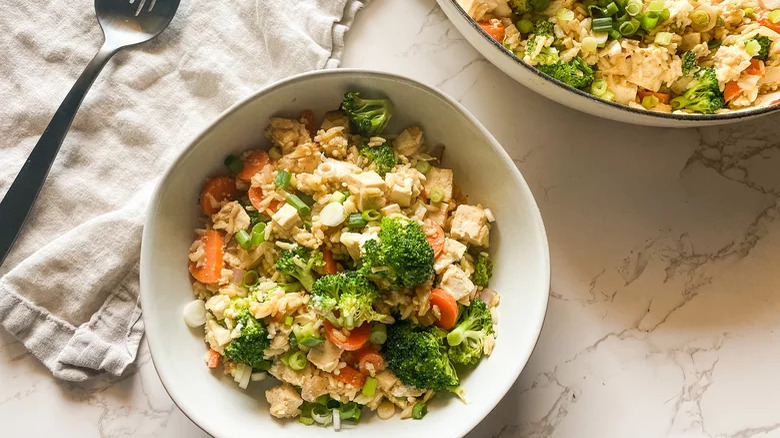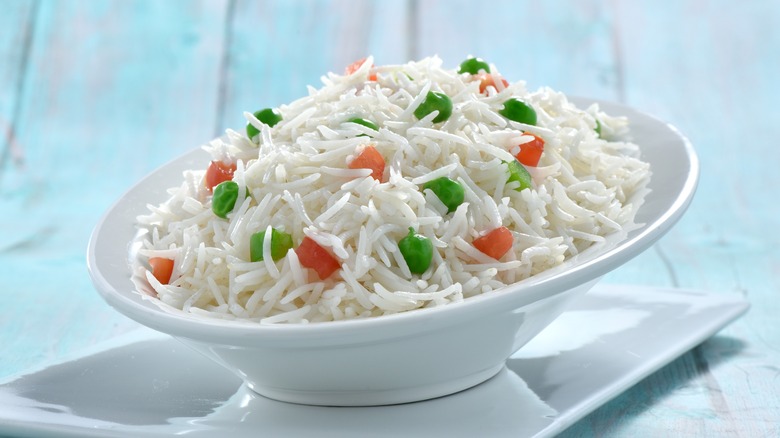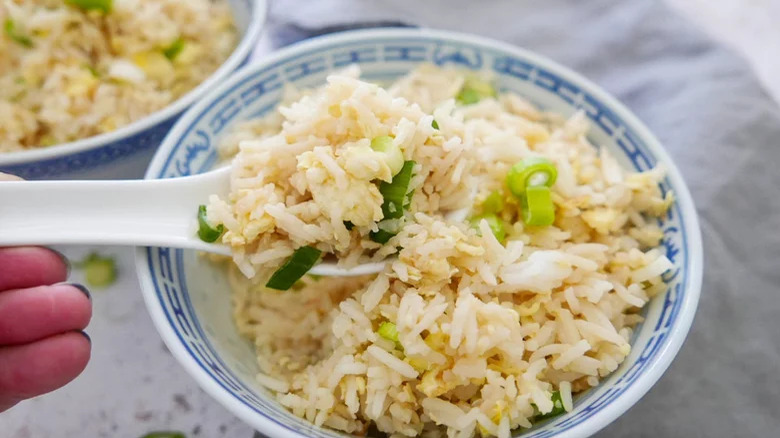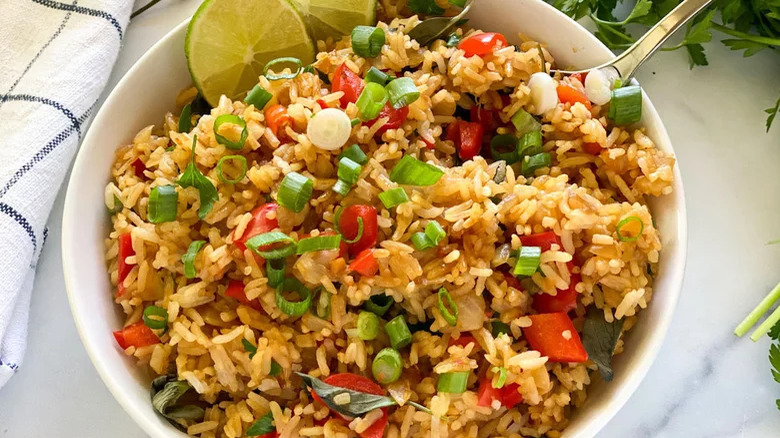14 Mistakes You're Making With Fried Rice
Affordable, tasty, and versatile with punchy flavors, fried rice is an Asian staple and a dish that's enjoyed across the world. In Indonesia, the traditional fried rice meal is nasi goreng while in Japan a classic fried rice dish is omurice. Saffron grains of rice showcase paella, which is a favorite in Spain, and you can add just veggies or throw in some seafood or meat as well — or both. You can spice fried rice up or give it a salty taste with a citrus tang.
In much of Asia, fried rice is served at any mealtime. It's as much a supper dish as it is served up to start the day. Try our breakfast fried rice recipe with spinach and eggs, top with avocado and add some bacon for an East meets West fusion dish. All that could hold you back from enjoying this culinary comfort are mistakes you're making with fried rice. Find out what these are and how to avoid them.
Choosing the wrong kind of rice
It's not that you can't fry any type of rice — it's just that some fry better than others, and it's a mistake not to know the difference. For example, you might find the starchy, high-calorie taste of short-grain sushi rice perfect for frying. However, as flavorful as it might be, it could prove to be too sticky to make a fried rice dish because of the sheer amount of starch it contains.
Thai jasmine rice is more robust than other grains — such as basmati — when it comes to frying. You can blast it with some wok heat action, and it won't disintegrate or turn into a starchy clump. Basmati is quite dry, and this, along with the lack of starch, makes it more brittle and less suitable for frying. The very fact that Thai cuisine contains so many fried-rice dishes is proof of how great the country's rice is for these types of recipes. If you're looking for inspiration then try our 20-minute pineapple fried rice recipe, which is a traditional dish from Thailand. Another important consideration is the taste of different kinds of rice, and how these complement the other ingredients you're using. If you want to cut down on starchy white rice then you might prefer to make fried brown rice instead, which is rich in fiber.
Not rinsing off starch before cooking the rice
You can't make fried rice without cooking the rice first. Like dried pasta, it takes more than a few minutes to cook rice, and therefore to make a wok-fired dish, you need the grains to be cooked and ready to sizzle in the pan. Your first step — and potentially your first mistake if you ignore it — is to rinse the rice before cooking it. You might do so to make sure there aren't any impurities in the rice if it's been scooped from a big bag in a store. However, the main reason is to wash away some of the starch. Starch may make shirt collars stiff, but when fried, it makes rice grains sticky.
Sticky rice isn't appealing when it's fried. Any seasonings and ingredients you add don't get mixed into the grains properly. If the rice isn't all stuck, together then the flavors can surround each grain, and it can also brown quickly. This results in a fluffy rice dish rather than a heavy one. Add the uncooked rice to a sieve and rinse under cold water. Dip your fingers in to circulate the grains and rinse away that pesky starch.
Not being adventurous with the taste
There's nothing wrong with keeping fried rice simple. That's what's so appealing about it in the first place. If you've got half a carrot, a wedge of onion, and some garlic, plus some leftover rice from your meal the night before, then you have a mouthwatering dish in the waiting. The mistake is to think you can't add whatever ingredients you like to your pan and use up what's left in your fridge.
However, the bigger mistake is to only fire up your wok for tasty but not necessarily flavorful dishes that excite the taste buds. Embrace how appetizing fried rice is, and how versatile, by being adventurous with the ingredients you use. Don't be afraid to be bold. For example, one recipe that really packs a flavor punch is our kimchi fried rice with Spam. The salty and sour taste is divine, and the perfect topping is a fried egg with shredded nori, sesame seeds, and green onions.
Not seasoning enough
No matter how you dress it up, fried rice without any seasonings is bland. Lean into the classic flavors of Asian cuisine by adding some salty soy. Meanwhile, the tang of rice vinegar lifts the flavor profile and gives the acidic notes a boost. Eggs cut through this beautifully and another ingredient you may not be used to adding to any savory dishes is a good sprinkling of sugar. This balances out the soy, and you don't need too much. You're not trying to sweeten the rice but to restrain the salt and acidic elements — and to boost umami as it caramelizes.
Another great ingredient to add is sesame oil — but use it sparingly as it can overpower any dish. The nutty, toasted notes can give fried rice a luxurious depth of flavor if they are subtle. It's best to use this oil as a seasoning at the end rather than frying the rice in it. Another great way to enhance your fried rice is to splash in some salty fish sauce, which is a must in Thai cooking, as well as the salty, sweetness of oyster sauce.
Not turning the heat up enough
If you're the type to sauté ingredients on low to medium heat, then it's time to turn it up, big style. In Asia, streetside woks are fired up with intense flames so that when the ingredients hit the oil, there's an instant frazzle. While your stovetop might not be able to match this level of heat, don't make the mistake of making slow-fried rice at a low temperature. If you're cooking on gas, turn it up so that the flames heat up the sides of the wok too. A good way to build up the frying power is by not continuously stirring the rice. Flatten it out a little along the bottom and sides of the wok and leave it to catch some color.
A great tip to make sure that all your ingredients cook evenly at a good heat setting is to fry them separately. For example, once you've got your oiled wok nice and hot, take it off the heat and fry your egg. Take the nearly-cooked scrambled egg out of the wok and next fry your protein, and any veggies. Take these ingredients out of the pan too. Before frying the rice get your wok super-hot. That way the moisture from the rice won't sit in the pan and create a steaming effect and will instead just burn off immediately.
Frying with the wrong type of oil
As well as a non-stick skillet or wok, you need a generous amount of oil to make good fried rice – but don't make the mistake of frying with the wrong type. What works best is a neutral oil as you don't want the taste of it to dominate the somewhat delicate flavors of rice, vegetable, and protein. And when you pour it into your wok, make sure you swish it around, so it covers the entire surface — including up the sides.
Another consideration is to use an oil that's got a high smoke point. You want to be able to heat up your wok to a high temperature. Canola is a great choice as is refined peanut oil. You can elevate Asian flavors with some toasted sesame oil – but not at the cooking stage as it will burn quickly. You might find it easier to squirt your oil onto the wok with a squeezy bottle rather than pour it from a bottle so that you can cover the surface. For Japanese-style fried rice, try using butter in place of oil or along with it. This will improve the browning and give your dish a more indulgent taste. Oils to avoid include coconut oil and olive oils, which are anything but neutral and flavor the rice too much. Avocado oil is ideal for its high smoke point and lack of taste. This way, the flavors you choose (ginger, kimchi, pineapple — whatever you want) can be the stars of the show.
Using a small pan
It's not that you can't use a skillet to make fried rice — it's just that a wok works so much better on so many levels. What is a mistake though is thinking you can get a lovely, evenly fried dish by using a pan that's too small. A small pan won't let you move the ingredients about, toasting them rather than burning, and allowing each grain of rice to brown beautifully. You're also likely to be left with grains all over the stovetop, nearby counter, and the flour if you use the wrong-sized pan. You need to be able to lift the rice and other ingredients without them going everywhere.
It isn't just the depth of a wok that makes it ideal for cooking fried rice. The shape of it affords a larger surface that heats up, and this means that as ingredients touch the sides, they're still being fried. In a traditional frying pan, the cooking area is the flat surface only. In a wok, it's literally the whole pan, so you can toss the grains, and they'll still fry evenly. Fried rice is a relatively quick dish to make, and that's in part because you use this bowl-shaped pan.
Thinking you can only use your stovetop
It's not that it's a mistake to use a wok to make fried rice — quite the opposite, as we just discussed. It's just that it's a culinary error to think that the stovetop is the only place that you can create this wonderfully simple yet mouthwatering dish. If you're cooking up a storm of Asian culinary creations on your stove, and don't have enough space, then you could try turning to your Instant Pot instead. You can cook quite delicate ingredients this way too, such as shellfish, and there's no compromise on taste.
Try our Instant Pot shrimp fried rice recipe, and as long as you follow the steps properly, you won't overcook the seafood. Cook the rice and other ingredients on the pressure cooker setting. You fry the shrimp in the Instant Pot first before taking it out and adding them again later. You want them to change color but not fully cook when you're first frying them. The advantage of cooking in this way is that there's little chance of you burning the rice since you're not having to deal with a large, hot wok. You can make quite flavorful recipes this way — such as our Instant Pot Thai fried rice with chicken. Once the rice is ready, add soy sauce, oyster sauce, and Sriracha hot sauce, and throw in some scallions and cashew nuts.
Splashing in too much soy sauce
As you quickly fry ingredients in a wok, it's easy to make mistakes. There isn't a lot of time to always consider what to add and how much. Unless you've measured everything out beforehand, you've got to make snap decisions. This is the beauty of cooking dishes like fried rice though. You can follow a recipe as a guide and tweak measurements and ingredients to create a zingy bowlful you just want to scarf.
However, while free-pouring soy sauce may sound liberating, don't go overboard. Add too much and your dish will taste salty, and it can even give the other ingredients a burnt aftertaste. Aside from ruining the flavor, a lot of soy transforms crisp rice grains into sopping wet ones and a dish that's no longer palatable. Proceed with caution — and remember, it's easier to add more than try to get rid of an overflow of soy sauce. Since you will no doubt serve soy sauce when eating the fried rice, hold back on how much you use when cooking. Try adding it once the dish is nearly done to the inside of the wok rather than directly on the food. This will flavor the ingredients and leave some of the salt behind on the hot pan.
Not adding any vegetables
Egg-fried rice that's served with Chinese dishes isn't exactly laden with loads of veggies. And that's fine as it's served as a fluffy side. However, you can definitely make more of a meal out of it by not skimping on vegetables. If you're wondering what to add, then there's no fixed answer, and that's what's so fantastic about fried rice! You really can add what you like. Just be sure to not use any watery vegetables that are going to turn your fried rice soggy.
Veg adds color, taste, and texture. Cut whatever you use small enough so that it mixes well with the grains and isn't tricky to eat. Whether you add carrots or spicy peppers — or both — make sure you give them a flash fry in your wok first, along with any aromatics like garlic before adding your rice. If you sauté onions, then put them on top of the rice once you've added it so that it doesn't burn. Make our quick hibachi fried rice recipe loaded with veggies such as onion, carrot, and sweet peas, but creative! Add green onions, broccoli, and baby corn to really flesh it out.
Leaving out the protein for an entrée
To bulk up fried rice and boost the flavor profile, don't make the mistake of leaving out any protein. What you add is up to you, and pretty much anything goes. You can use raw protein, and cook it in your wok before adding the cooked rice, or even throw in some protein that's already been cooked, such as some rotisserie chicken. Make our chicken fried rice by frying a chopped chicken breast with onions, adding garlic, ginger, and mixed veggies, followed by rice and a soy sauce, brown sugar, and rice wine vinegar sauce.
If you prefer pork fried rice, then fry carrot, ginger, and garlic with ground pork until the meat is cooked through. Add frozen peas and green onions with the cooked rice and stir-fry sauce. If you're really hungry, then top each serving with a fried egg. Want a vegetarian-friendly or a meat-free dish? Then follow our tofu fried rice recipe and add the protein to the pan with the rice rather than sauté it beforehand.
Frying wet rice
There's nothing worse than stodgy fried rice. When you dig your fork in a bowl of leftover steak fried rice, it shouldn't feel like you're shoveling wet concrete. The best fried rice is full of flavor — and it should be light and airy. To achieve that hallmark texture of individual fried grains, you need to avoid using wet rice at all costs. Let cooked rice cool down properly before you use it so that it dries out a little. If you can, it's best to use it when it's a day old. That way, it's lost some of its wetness and will fry so much better.
If you add hot cooked rice to a baking sheet and leave it out on the counter, this will help. You can also keep leftover rice in the fridge so that even more moisture evaporates. A great tip is to separate the grains with your fingers first, adding a layer of cooked rice to a baking sheet. Leave this tray in the refrigerator overnight. The dry grains will fry to create a nutty fried-rice texture rather than a steamed mush. Once out of the fridge, you can rub the grains to break them up again. Adding a little oil to your hands can help.
Adding uncooked egg to the rice
An absolute no-no when making fried rice is to add beaten egg to the grains in the wok in the hope that they will turn fluffy. They won't, and the whole dish will become a soggy mess. You've been warned. This is fried rice rules 101. Start by whisking eggs so that the yolks and whites are mixed together. Fry the eggs in a wok without browning or overcooking. Once they look a little scrambled and cooked, take them out. Add them again when the rice is fried and your dish is nearly done.
Follow our easy egg-fried rice recipe by shaking beaten eggs in the wok with a little salt. Instead of taking them out, add the rice just before the eggs are nearly ready. The only other ingredients you need are some soy sauce, and possibly a little more salt. Garnish with scallions. You can also shift your rice to the side and crack eggs in the wok too. Just be sure to only mix them together once the eggs have been scrambled and cooked.
Leaving out a citrus spritz at the end
In Thailand, fried rice usually comes with a long green onion on the side and a wedge of lime. This isn't just garnish. Squeeze some citrus juice on your finished dish and taste the difference. You can also add some in while the ingredients are frying, but you definitely need a spritz at the end. If you don't have any limes, then you can use lemons instead. What you want to create is a moreish contrast between the salt of the soy sauce or fish sauce and the sour bite of the fruit. One Reddit commenter suggests adding some lime zest over the fried rice using a Microplane.
To make spicy Thai fried rice, you boost the saltiness with soy sauce, oyster sauce, and fish sauce. Jasmine rice, cilantro, and Thai basil bring a fragrant quality. Thai chilis, red pepper, onion, and garlic add some heat while sugar sweetens the dish. You add lime juice once the rice is fried, and your wok is off the heat. Serve with lime slices to create a sharper, fresher flavor. Who knew fried rice could be so amazing? As long as you don't make these mistakes that is.
